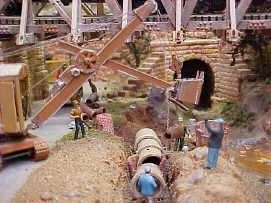
|
|

Jump To:
The Kade was originally a design concept consisting of a logo and paint scheme applied to various scratch-built and detailed rail cars over the years. The name came from use of two letters of my name and my son, Kevin, for his first train under the Xmas tree. Construction of a layout was begun at home in 1956 but ceased when I joined a local club instead. Construction and operations were done in conjunction with that local railroad club for over 30 years. The club disbanded and I retired, so the need arose for the construction of a home layout in 1989.
The setting for the Kade Railroad is the western region of West Virginia. Staging tracks from the east (Brunswick) enter the scene at Grafton and proceed west through such towns as Monongah, Fairmont, Catawba, Tappan and Parkersburg. The focus of the layout is the fictitious Kade Railroad and its connections with both the Western Maryland near Monongah and the Baltimore & Ohio around Grafton. This combination offers a variety of equipment and industrial possibilities. The era is the mid-1950's when both steam and 1st generation diesels share the track. Passenger service is still alive and freight trains serve the local industries before trucks! A major industry is coal handling in all of its forms with hopper cars out-numbering all other types. Rural timber operations also keep the Colfax sawmill at capacity.
The Kade layout was begun in the fall of 1989 without much pre-planning! A small loop of test track located in a corner of the basement grew into more than 950 feet of track with over 153 turnouts. The layout blankets the four exterior walls and several interior walls. The layout is primarily supported from the ceiling at an average height of 55 inches, using 1/8 inch threaded rods into the ceiling studs. Only one layout leg to the floor is in use. Narrow sections are supported with right angles screwed to the walls. Basic framework is wood with ½ inch plywood and ½ inch homasote base. Raised terrain is builder's foam covered with hydracal soaked towels and colored with water-based paints. A large mountain is constructed of chicken wire allowing entry inside to reach hidden track work. Scenery is highly detailed utilizing many homemade molds for both metal and plaster products. Backdrops are hand painted for sky and clouds. Deciduous trees are largely dried blossoms of the Purple Smoke Tree located in my yard.
Originally the layout electrical supply consisted of a manual block system. Numerous control panels are located around the layout containing schematics of the local trackage with the associated block switches and turnout controls. Eleven cabs operated the trains of which four were walk-around mainline cabs and the rest were dedicated to local switching areas. High frequency current was added to the rails to power car lights and engine sound units. In 2002 the conversion to digital command control was made using the Digitrax system with three power units. Most of the block toggles were retained to ease finding the location of an electrical short in those three power areas. Each power area is then further split using Tony's Train Exchange Power Shields to give a total of thirteen isolated short areas on the layout. Four reverse tracks are also automated using Tony's Power Shield Reversers. Sixty engines have either Soundtraxx or Digitrax decoders installed. Every consist running has at least one sound equipped power unit. Conversion took six months to return to the first operating session.
Modelers in the South Jersey Operators Group meet each Friday to operate a variety of model railroads. All the railroads use a variety of card systems to work in a prototype fashion over a three-hour session. Newcomers are always welcome to join in an operating session.
The layout is open to the public each November in conjunction with National Model Railroad Month. Dates are published in local papers and in a four state open house listing available in many hobby shops at that time. The layout has also been open for modelers in the past attending national, regional and local conventions in this area.
MODEL RAILROADING IS FUN
DAVID SKINNER, (MASTER MODEL RAILROADER #266)
end